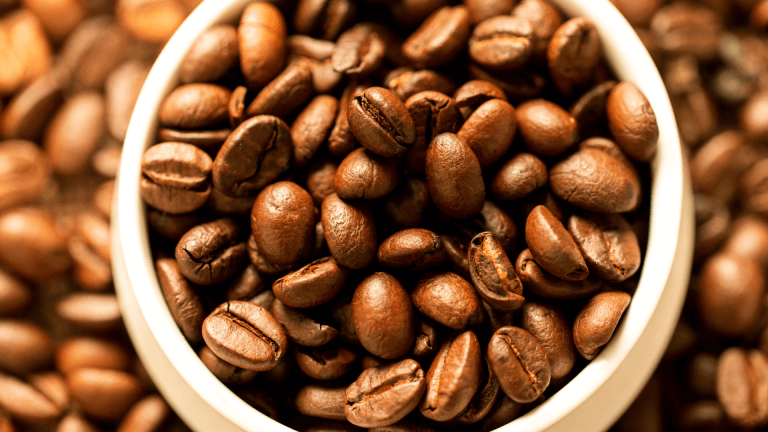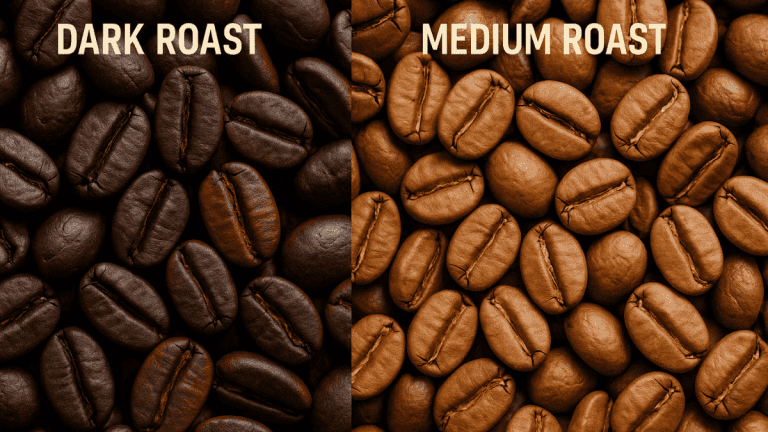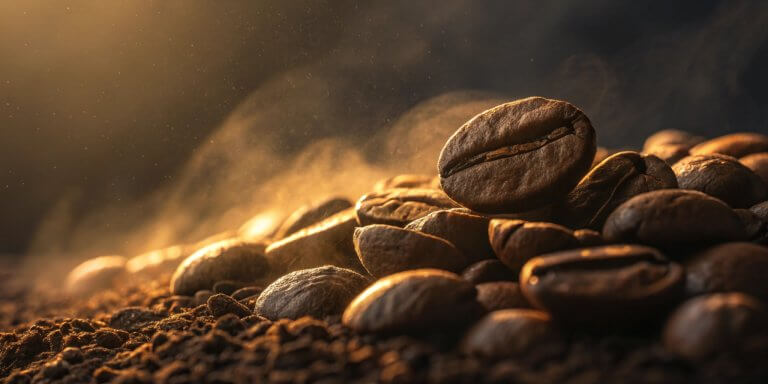
Most of us can’t imagine starting our day without that first delicious cup of coffee. The world seems to revolve around this rich, dark liquid, but have you ever thought about where those coffee beans come from? They don’t just magically appear in our kitchens, right?
This blog post will take you on an exciting journey to discover from where do coffee beans come from and the incredible adventures they experience before ending up in our cups. We’ll explore everything from the types of coffee plants to the regions where they grow, the harvesting and processing methods, and even the art of roasting that brings out those fantastic flavours. Get ready to uncover the secrets of your daily caffeine fix!
Types of Coffee Plants
Okay, let’s clear up a common misconception: those little brown wonders we call “coffee beans” aren’t beans at all! They’re seeds, carefully extracted from the fruit of the coffee plant, a fascinating flowering shrub that brings us our daily dose of caffeine. Imagine a berry bush or a grapevine, but instead of juicy berries or grapes, it produces these vibrant red or purple fruits called coffee cherries. Nestled inside each cherry, you’ll find two coffee beans – or, more accurately, seeds – waiting to be discovered. It’s like nature’s little surprise package!
The coffee plant family is diverse, with over 120 species, each with its quirks and characteristics. However, Arabica and Robusta are the two leading players that rule the coffee world.
- Arabica is sophisticated and known for its smooth, sweet flavour with delicate hints of chocolate, caramel, and nuts. It’s like sipping on a luxurious dessert! Arabica plants are a bit picky, though, preferring higher altitudes and cooler climates.
- On the other hand, Robusta is bold and adventurous, with a strong, intense flavour and a much higher caffeine kick. It’s the perfect choice for those mornings when you need an extra boost! Robusta plants are more demanding and can handle harsher conditions.
While Arabica and Robusta dominate the coffee scene, a few lesser-known varieties, like Liberica and Excelsa, add their unique flavours to the mix. They might not be as famous, but they’re worth exploring for the adventurous coffee lover!
Coffee Growing Regions
The “Coffee Belt” is a band of countries encircling the globe, nestled between the Tropics of Cancer and Capricorn, where coffee cultivation thrives. This region boasts the perfect climate and growing conditions for those precious coffee plants to flourish. Imagine warm, tropical temperatures, ample sunshine, and just the right amount of rainfall – it’s a coffee paradise! Arabica beans, those delicate little divas, demand gentle warmth and light, while their robust cousins, the Robusta beans, can handle a bit more of a challenge. But no matter the species, coffee plants need fertile soil and water to produce the flavorful beans we crave.
Now, let’s take a trip around the Coffee Belt and explore some of the top coffee-producing regions:
Africa and the Middle East
- Ethiopia: The birthplace of coffee, Ethiopia is renowned for its diverse and complex coffee flavours, ranging from bright and citrusy to floral and fruity.
- Kenya: Kenyan coffee is celebrated for its bright acidity, entire body, and black currant flavour notes.
- Tanzania: Tanzanian beans offer a balanced cup with a medium body and hints of chocolate and berries.
- Uganda: Uganda is a significant producer of Robusta coffee, known for its strong, intense flavour.
South and Central America
Southeast Asia and the Asia Pacific Region
Thanks to the intricate interplay of climate, soil, and cultivation techniques, each coffee-producing region offers a unique taste of the world. So next time you enjoy a cup of coffee, take a moment to appreciate the incredible journey it has taken from a tiny seed in the Coffee Belt to your cup.
How Do Coffee Beans Grow?
The journey of a coffee bean from a tiny seed to the aromatic brew in your cup begins with careful cultivation. This process requires patience, expertise, and a deep understanding of the coffee plant’s needs.
Planting the Seeds of a Rich Brew
The initial stages of coffee cultivation occur in nurseries, where coffee seeds are carefully planted in shaded beds, providing a protected environment to germinate and grow. After sprouting, the seedlings are transplanted into individual pots, allowing their roots to establish and strengthen. Once the seedlings are robust enough, they are transplanted to coffee farms, where they will mature and eventually produce those precious coffee cherries. This meticulous process takes time. Coffee plants typically begin to flower in about a year, but it takes around three to four years to produce red coffee cherries and up to 10 years to produce commercially.
How Is Coffee Harvested?
Coffee cherries are generally harvested annually, usually between May and October, when they have reached their peak ripeness, transforming from a vibrant green to a deep, rich red. The harvesting method plays a crucial role in determining the quality and flavour of the final coffee.
There are two main approaches:
The choice of harvesting method often depends on factors such as the size of the farm, the terrain, and the desired quality of the coffee. Smaller farms, particularly those focused on speciality coffee, often opt for selective picking to ensure the highest quality beans. More extensive, commercial farms may utilize strip picking due to its efficiency.
How Are Coffee Beans Processed?
Once those vibrant coffee cherries are harvested, coffee processing is the next crucial step in their transformation. This intricate process aims to remove the outer layers of the fruit, revealing the precious beans within, each a tiny treasure trove of flavour waiting to be unlocked. The chosen method significantly impacts the final taste and aroma of the coffee, adding another layer of complexity to this beloved beverage.
Here are the four main methods of coffee processing:
The art of coffee processing is a testament to the ingenuity and expertise of coffee farmers worldwide. By carefully selecting the processing method, they can manipulate and enhance the inherent flavours of the coffee bean, creating a vast and exciting array of flavours for coffee lovers to explore.
Transforming Green Beans into Aromatic Delights
Coffee roasting is a crucial step that transforms those dull, grassy-tasting green coffee beans into the aromatic, flavorful delights we eagerly anticipate each morning. By carefully applying heat, the roaster unlocks the beans’ hidden potential, developing their characteristic flavours and aromas.
The roasting process significantly impacts the coffee beans’ caffeine content, acidity, and overall flavour profile. As beans roast, they lose moisture and increase in size. The longer the roast, the more caffeine is lost; the darker the roast, the less acidity it retains.
Different roast levels cater to various flavour preferences:
Roasting techniques also play a role in flavour development. Drum roasting, the traditional method, uses a rotating drum heated from below to roast the beans. This method allows for greater control over the roasting process and produces even roasts. Air roasting, a newer technique, utilizes hot air to roast the beans, resulting in a cleaner, brighter flavour profile.
The roaster’s expertise and artistry are evident in the nuanced flavours they coax from each batch of beans. Through careful manipulation of time, temperature, and roasting techniques, they create a symphony of aromas and flavours that captivate coffee lovers worldwide.
Delving Deeper into the World of Coffee
The world of coffee extends far beyond the familiar names of Arabica and Robusta. Within these two species lies a captivating array of varieties, each with its distinct flavour profile, growing conditions, and origin story. Let’s embark on a journey to explore some of these unique coffee gems.
Beyond Arabica and Robusta: Exploring Unique Coffee Varieties
Arabica, known for its smooth, nuanced flavours, boasts a diverse family of varieties, including:
While often associated with its bold, intense flavour, Robusta exhibits variations within its ranks.
For those seeking genuinely extraordinary coffee experiences, there are rare and speciality varieties that will tantalize the taste buds:
Decaffeination Demystified: How Caffeine Is Removed
While the allure of caffeine draws many to coffee, some seek the rich flavours and
aroma without the stimulating effects. Decaffeination, the process of removing caffeine from coffee beans while preserving their inherent flavours, offers a solution. It is important to note that there are no decaf coffee beans. All coffee beans naturally contain caffeine. The decaffeination process takes place before roasting, using various methods to extract the caffeine from the green coffee beans.
There are several decaffeination methods, each with its approach to caffeine removal.
- Some methods use chemical solvents to extract the caffeine. However, concerns about potential residual solvent traces have led to the development of more natural methods.
The Swiss Water Process, a popular and widely respected method, stands out as a natural and chemical-free option. It utilizes osmosis and selective filtration to remove caffeine without solvents, preserving the coffee’s delicate flavours and aromas.
Coffee decaffeination allows coffee enthusiasts to enjoy the rich tapestry of coffee flavours without the jolt of caffeine, offering a more relaxed and enjoyable coffee experience.
Conclusion
From the lush coffee farms nestled in the Bean Belt to the steaming cup that awakens our senses each morning, the journey of coffee beans is a testament to the intricate interplay of nature, human ingenuity, and passion. Each stage demands unwavering dedication and expertise, from cultivating the delicate coffee trees to meticulously roasting the beans.
Understanding coffee origins unlocks a world of flavour and appreciation for the diverse characteristics of coffee beans. The soil, climate, altitude, and processing methods are unique to each region, shaping the beans’ inherent flavours and creating a captivating tapestry of tastes for coffee enthusiasts to explore.
Embark on a journey of coffee discovery by venturing beyond the familiar. Explore different coffee origins, roasts, and brewing methods to unlock a world of flavour and find your personal favourites. As you savour each cup, remember the hands that nurtured the beans and the journey they undertook to reach your cup.
Consider supporting sustainable coffee farming practices and ethical sourcing. This will ensure that the environment and the hardworking farmers who cultivate this beloved beverage are treated with respect and fairness.

